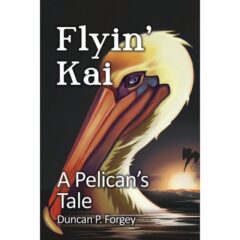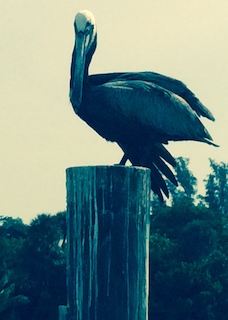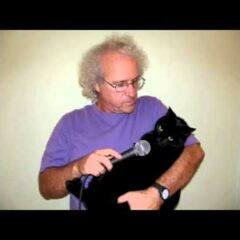
Duncan P. Forgey: ‘Mother Nature is going to come teach us a lesson, and I think she’s doing that right now.’
A Novel Novel Warns of Climate Change—With A Pelican Hero
By Duncan Strauss
Without wanting to get too cute, you could say Duncan P. Forgey’s Flyin’ Kai: A Pelican’s Tale has “distinctive story” written all over it.
By which, I mean approaching the novel head-on, it’s distinctive in a fistful of ways, including that the hero is a pelican. A pelican who talks. (Insert your own Talking Animals joke here.)
But the Flyin’ Kai backstory is distinctive, too, marked by a 50-year gestation period. There’s even a piece of sub-backstory that’s quirky: how Duncan Forgey played a role in my being named Duncan. We’ll get to all of those. (Well, not the Duncan/Duncan explanation; that isn’t particularly germane, and you can hear it in the radio interview.)
 First, let’s focus on Flyin’ Kai: A Pelican’s Tale, in which Forgey has spun an inventive yarn, with protect-the-environment-and-wildlife themes prominent amidst this innovative narrative framing the perils of climate change, propelled by a coming-of-age saga of sorts: the titular Kai is a quintessential adolescent (albeit, an adolescent pelican) on an odyssey.
First, let’s focus on Flyin’ Kai: A Pelican’s Tale, in which Forgey has spun an inventive yarn, with protect-the-environment-and-wildlife themes prominent amidst this innovative narrative framing the perils of climate change, propelled by a coming-of-age saga of sorts: the titular Kai is a quintessential adolescent (albeit, an adolescent pelican) on an odyssey.
The cautionary story reflects Forgey’s childhood spent in a coastal town situated between Los Angeles and San Diego, an area he feels has been severely compromised by rampant development. “I grew up on the California coast, Southern California, in a town known as Newport Beach,” Forgey recalled in a Talking Animals interview.
“And I still use the word town, even though it’s no longer that. But we grew up in a Southern California that was absolutely magical in its natural setting. That’s where I really understood the importance of nature, and children having the ability to run around freely in a natural setting.
“We had huge migrations of swallows once a year that would come up to the local [San Juan Capistrano] mission, and they traveled 6,000 miles to get there. And that has basically been disrupted. We had terns and monarch butterflies that would do these tremendous migrations. And Southern California was just this wide open, beautiful, somewhat agricultural, area.”
(Editor’s Note: The swallows’ migration to Capistrano was memorialized in a 1940 hit song written by Leon René and first recorded by the Ink Spots with their incomparable lead singer, Bill Kenny. It rose to #8 on the U.S. chart, was barely outpaced later that year by Glenn Miller’s #2 version and thereafter was most notably covered–#80 on the chart–by Pat Boone in 1957 as the B side of his hit single, “April Love.”)
A moment later, Forgey added, “Just a little side note: my family goes back six generations in Southern California, all the way to the Pueblo de Los Angeles, and the Spanish families that owned some of the big ranches and rancheros. When I lived in Southern California, it was everything to me. And, in three generations, to watch it change completely has just been heartbreaking.”
That emotional laceration, that profound sorrow—and alarm that this same kind of environmental unraveling will play out globally if actions causing climate change aren’t quickly halted—forms a fundamental underpinning of Flyin’ Kai.
It also prompted Forgey to relocate to Kauai, approximating the idyllic coastal grandeur of his beloved Newport Beach in its heyday. “That’s why,” he said, “I’m now sitting on this beautiful island in the Pacific Ocean.”
He’s living in a place that hasn’t been compromised in the way his native Newport Beach experienced—in some ways, he’s traveled back to the future. But recognizing that most people aren’t in the position to make this kind of move, he’s seeking to impart his perils-of-climate-change message, but doing so in his guise as a storyteller.
That quest to function as a storyteller, and to tell at least a portion of the Flyin’ Kai story, spans some five decades.
“Basically, I started writing this book in 1969, when I was a senior in college in L.A.,” Forgey said. “And what I’d never realized was that by doing that, that was my teenager. Kai is a teenager. He’s young, all that at the beginning. And so, I had an adolescent–an older adolescent–writing the story about an adolescent.
“That gave me everything I needed to do to create this wonderful character, and all of his insecurities, his tendency to be impatient, and wanting to know about what’s going to happen in life, but not listening to the people around him that were important to him.”

The book that inspired the young Duncan to write Flyin’ Kai
It’s important to note that in this period that Forgey was an adolescent, fashioning a fictional adolescent, there was a literary phenomenon dominating the cultural landscape: Jonathan Livingston Seagull, a novella by Richard Bach, about a seagull who is trying to learn about flying, then going on to explore deeper qualities, like introspection, freedom and independence. The book was a gigantic bestseller.
“That was the book that inspired the young Duncan to write” Flyin’ Kai, Forgey said. Curiously, he didn’t think of himself as a writer then.
So how did a college kid at the University of Southern California (USC), majoring in history, but with no literary bent, decide to write a novel?
“As with so many times, this kind of a story goes back to a special teacher,” he said. “I had a professor at [U]SC, and her name was Anne Pearce Kramer. It was during the rebellious period of the ’60s. And she was able to get a class called ‘Censorship.’ So, of course, being a young, active person of the ’60s, I wanted to take it.
“She just happened to be a movie actress of the 1950s, not super famous for her acting. But she was a beautiful, wonderful lady. And she was the ex-wife of [noted director] Stanley Kramer. Well, she had this class. At that time, I was writing poetry when I got bored in my history classes. I was writing, but I was not an English major or even a writer, really, in that sense.
Forgey recounts that Kramer assigned a term paper dealing with censorship, and the piece he turned in apparently wowed her. Her response was so enthusiastic, he said, “she built me up to such a place that I decided I wanted to be a writer. Really fantastic educators can do that for a person.
“Now, of course, I delayed it 50 years. But, hey, the experiences I’ve had in those 50 years is making me the writer I am today.”
In this case, procrastination—even 50 years’ worth–turns out to be a laudable virtue.
That long marination likely helps account for Flyin’ Kai emerging as a smooth, inventive triumph. It’s a honed and cohesive saga that, in lesser hands, or maybe with less work and fewer drafts, could have really jumped the rails and become a mess. But it didn’t, and it’s not. Kirkus Reviews accorded the book all kinds of praise, including “Avian characters inspire in this appealing environmental tale.”
Of course, the central “avian character” is Kai, who, with all his adolescent impulses firing at peak intensity, and sensing the grass may be greener on the other side (in a manner of speaking) embarks on a journey. Initially, in his travels, he aims to explore a region called Magical Mountain, which he quickly realizes ain’t so magical anymore, with its nature and beauty having been sullied by mankind’s actions.
As Kai’s trek continues, he meets and joins forces with Pancho, a blue-footed booby bird, and they encounter additional distressing signs of pollution and other environmental damage. As the pair travels further, and witnesses—and reports–more harm, if you missed the memo noting the havoc climate change has already wreaked, you’d have to be, well, a bird brain.
For the Talking Animals crowd, another key stop on our dynamic duo’s expedition is a place that’s a thinly disguised facsimile of SeaWorld. Kai and Pancho spend some time chatting with the resident animals, who profess they have a terrific life there, including receiving excellent care, the water in their tanks remains a consistent temperature, they never have to worry where their next meal is coming from, and so on. Kai and Pancho seem dubious.
 Forgey explains that in working on the book, he contemplated some of the key traits of marine theme parks, spurring further reflection. “It got me thinking about the lions and tigers in the zoos,” he said. “We go there and we get fascinated by the lions and tigers in the zoos as young people. What is it like for the animals to be living in that environment?”
Forgey explains that in working on the book, he contemplated some of the key traits of marine theme parks, spurring further reflection. “It got me thinking about the lions and tigers in the zoos,” he said. “We go there and we get fascinated by the lions and tigers in the zoos as young people. What is it like for the animals to be living in that environment?”
Forgey continued, “From a wild animal’s point of view, there’s got to be something going on inside their heads.”
That meditation yielded the book’s powerful SeaWorld-esque passage–a striking and provocative instance of pondering the salient issues revolving around captive animals, performing animals, and what their lives truly entail.
Another potent portion of Flyin’ Kai involves a hurricane, the kind of dramatic meteorological event that, these days, appears to wield more destructive power, owing to—that’s right—climate change. Starting with warmer ocean waters fueling the increasing intensity of these massive storms.
And so, the hurricane in the book extends Forgey’s core thesis, depicting the pitfalls of climate change, by way of an inexplicit literary urging to halt actions that contribute it.
Forgey’s convinced that there isn’t much time for that halting, that a major clock is loudly ticking. “Mother Nature is going to come teach us a lesson,” he said, “and I think she’s doing that right now.”
Follow this link to hear the Duncan Forgey interview on this edition of Talking Animals
 Combining his passions for animals, radio, journalism, music and comedy, Duncan Strauss launched Talking Animals at KUCI in California in 2003. Since late 2005 the show has aired on Tampa’s WMNF. Producer-host Strauss lives in Jupiter Farms, FL, with his family, including four cats, two horses and one dog. He spends each day talking to those animals, and maintains they talk right back to him, a claim as yet unverified by credible sources.
Combining his passions for animals, radio, journalism, music and comedy, Duncan Strauss launched Talking Animals at KUCI in California in 2003. Since late 2005 the show has aired on Tampa’s WMNF. Producer-host Strauss lives in Jupiter Farms, FL, with his family, including four cats, two horses and one dog. He spends each day talking to those animals, and maintains they talk right back to him, a claim as yet unverified by credible sources.

